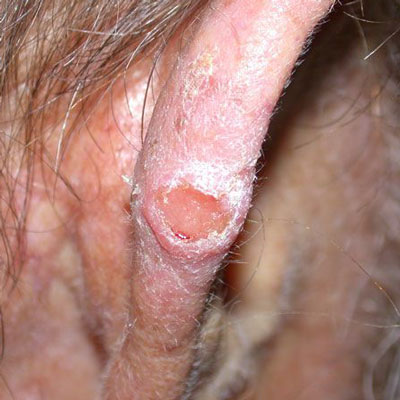What is Squamous Cell Carcinoma?
Squamous (rhymes with famous) cell carcinoma is the second most common type of skin cancer. There are about 700,000 cases of squamous cell carcinoma each year in the United States. It comes from squamous cells which form the outer layer of the epidermis (the top layer of skin). They can grow anywhere on the body, but are far more common in sun exposed areas like the rim of the ear, lower lip, the face, bald scalp, forearms and backs of the hands. They often look like red or skin colored patches or bumps and are often scaly. Many times, they look like warts or even just a patch of dry skin.
Unlike basal cell carcinomas which seldom spread, squamous cell carcinomas can get into the lymph nodes and blood and metastasize. Early treatment almost always prevents this. The tumors that more often spread are ones that are very large, located on the head, neck, or genitals, and have recurred after a previous treatment. The overall rate of metastases is about 2%, but metastatic squamous cell carcinoma is difficult to treat and leads to about 2,500 deaths per year.
Who gets Squamous Cell Carcinoma?
There are several risk factors for squamous cell carcinoma:
- People who have fair skin, light hair, and light colored eyes
- Anyone with a history of lots of sun exposure, especially people who work outdoors like farmers, ranchers, or construction workers, as well as people who spend a lot of leisure time in the sun such as golfers, boaters, mountain climbers, and gardeners.
- Anyone who has a different type of skin cancer
- People who are on long-term immune suppression because of an organ transplant or other medical condition. Organ transplant patients have a risk of squamous cell cancer that is 65x greater than normal and should be seen each year for surveillance.
- People with a history of lymphoma or HIV.
Squamous cell carcinoma happens in men at least twice as much as in women. It’s unusual for them to occur before age 50.
People with dark colored skin get very few skin cancers in general, but the majority of skin cancers in African-Americans are squamous cell carcinomas.
What Causes Squamous Cell Carcinoma?
The sun. Chronic sun exposure is the cause of most squamous cell cancers.
Tanning bed usage also increases the risk of skin cancer by about 2.5x.
Chronic inflammation of the skin also contributes to squamous cell carcinoma and tumors are sometimes seen in burns, scars, ulcers, long-standing sores and sites previously exposed to X-rays or certain chemicals (such as arsenic and petroleum by-products).





